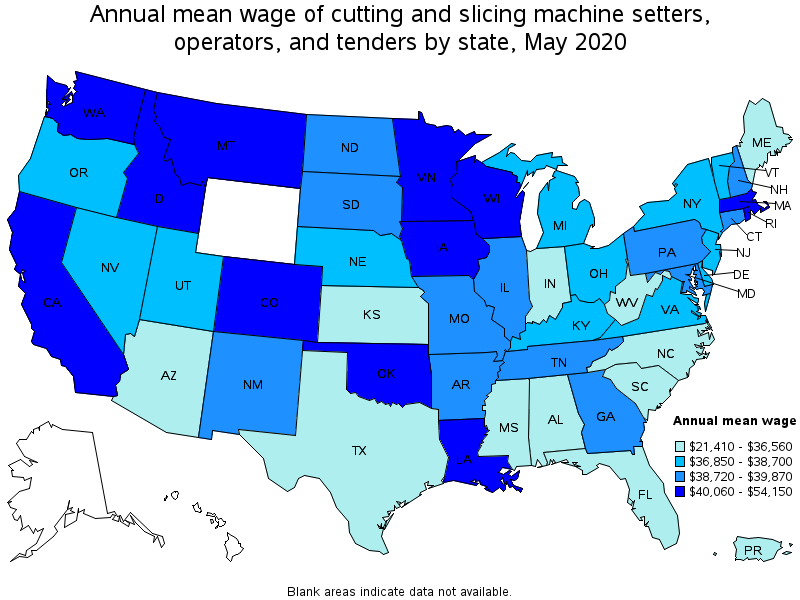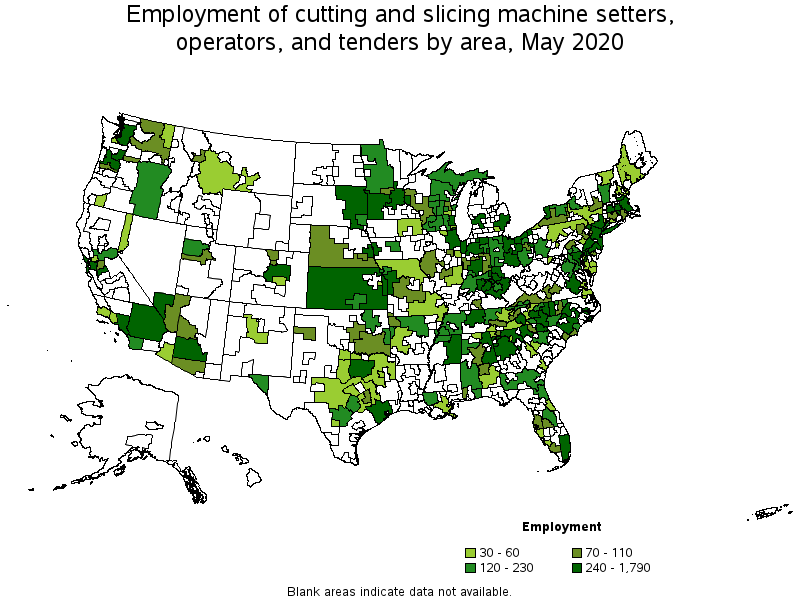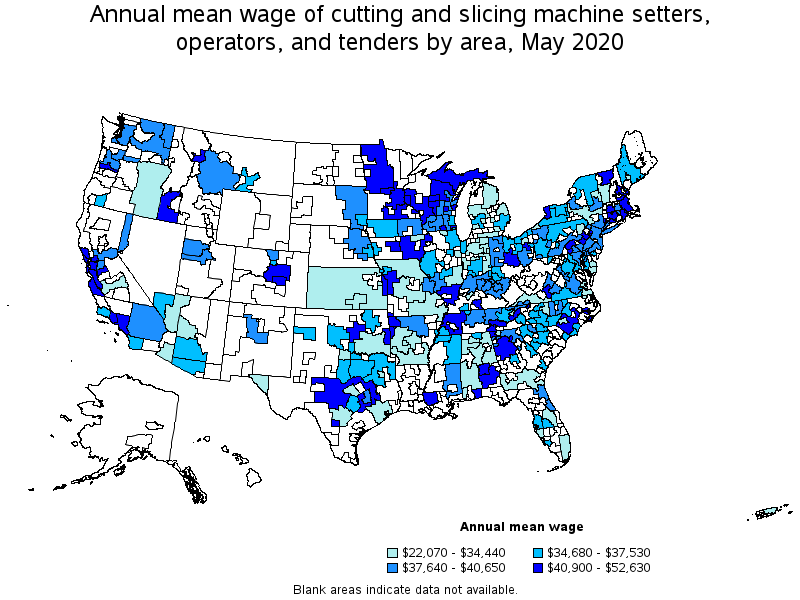An official website of the United States government
 United States Department of Labor
United States Department of Labor
Set up, operate, or tend machines that cut or slice materials, such as glass, stone, cork, rubber, tobacco, food, paper, or insulating material. Excludes "Cutting, Punching, and Press Machine Setters, Operators, and Tenders, Metal and Plastic" (51-4031), "Textile Cutting Machine Setters, Operators, and Tenders" (51-6062), and "Woodworking Machine Setters, Operators, and Tenders" (51-7040).
Employment estimate and mean wage estimates for Cutting and Slicing Machine Setters, Operators, and Tenders:
| Employment (1) | Employment RSE (3) |
Mean hourly wage |
Mean annual wage (2) |
Wage RSE (3) |
|---|---|---|---|---|
| 52,760 | 2.5 % | $ 18.37 | $ 38,220 | 0.5 % |
Percentile wage estimates for Cutting and Slicing Machine Setters, Operators, and Tenders:
| Percentile | 10% | 25% | 50% (Median) |
75% | 90% |
|---|---|---|---|---|---|
| Hourly Wage | $ 12.61 | $ 14.56 | $ 17.78 | $ 21.86 | $ 25.31 |
| Annual Wage (2) | $ 26,230 | $ 30,290 | $ 36,980 | $ 45,470 | $ 52,650 |
Industries with the highest published employment and wages for Cutting and Slicing Machine Setters, Operators, and Tenders are provided. For a list of all industries with employment in Cutting and Slicing Machine Setters, Operators, and Tenders, see the Create Customized Tables function.
Industries with the highest levels of employment in Cutting and Slicing Machine Setters, Operators, and Tenders:
| Industry | Employment (1) | Percent of industry employment | Hourly mean wage | Annual mean wage (2) |
|---|---|---|---|---|
| Nonmetallic Mineral Product Manufacturing | 11,400 | 2.84 | $ 18.57 | $ 38,620 |
| Converted Paper Product Manufacturing | 8,380 | 3.18 | $ 19.95 | $ 41,490 |
| Printing and Related Support Activities | 4,500 | 1.15 | $ 18.22 | $ 37,890 |
| Rubber Product Manufacturing | 4,000 | 3.30 | $ 18.39 | $ 38,250 |
| Plastics Product Manufacturing | 3,760 | 0.67 | $ 16.79 | $ 34,920 |
Industries with the highest concentration of employment in Cutting and Slicing Machine Setters, Operators, and Tenders:
| Industry | Employment (1) | Percent of industry employment | Hourly mean wage | Annual mean wage (2) |
|---|---|---|---|---|
| Leather and Hide Tanning and Finishing | 100 | 3.63 | $ 17.81 | $ 37,050 |
| Rubber Product Manufacturing | 4,000 | 3.30 | $ 18.39 | $ 38,250 |
| Converted Paper Product Manufacturing | 8,380 | 3.18 | $ 19.95 | $ 41,490 |
| Nonmetallic Mineral Product Manufacturing | 11,400 | 2.84 | $ 18.57 | $ 38,620 |
| Pulp, Paper, and Paperboard Mills | 1,470 | 1.61 | $ 22.74 | $ 47,290 |
Top paying industries for Cutting and Slicing Machine Setters, Operators, and Tenders:
| Industry | Employment (1) | Percent of industry employment | Hourly mean wage | Annual mean wage (2) |
|---|---|---|---|---|
| Other Specialty Trade Contractors | 80 | 0.01 | $ 24.79 | $ 51,570 |
| Commercial and Service Industry Machinery Manufacturing | 100 | 0.11 | $ 22.89 | $ 47,620 |
| Pulp, Paper, and Paperboard Mills | 1,470 | 1.61 | $ 22.74 | $ 47,290 |
| Chemical Manufacturing (3255 and 3256 only) | 120 | 0.07 | $ 22.69 | $ 47,200 |
| Steel Product Manufacturing from Purchased Steel | 200 | 0.36 | $ 22.23 | $ 46,230 |
States and areas with the highest published employment, location quotients, and wages for Cutting and Slicing Machine Setters, Operators, and Tenders are provided. For a list of all areas with employment in Cutting and Slicing Machine Setters, Operators, and Tenders, see the Create Customized Tables function.

States with the highest employment level in Cutting and Slicing Machine Setters, Operators, and Tenders:
| State | Employment (1) | Employment per thousand jobs | Location quotient (9) | Hourly mean wage | Annual mean wage (2) |
|---|---|---|---|---|---|
| North Carolina | 3,950 | 0.92 | 2.43 | $ 17.49 | $ 36,380 |
| California | 3,390 | 0.21 | 0.54 | $ 19.73 | $ 41,030 |
| Illinois | 2,770 | 0.49 | 1.30 | $ 18.65 | $ 38,780 |
| Texas | 2,760 | 0.23 | 0.60 | $ 16.55 | $ 34,420 |
| Ohio | 2,330 | 0.45 | 1.19 | $ 17.89 | $ 37,210 |

States with the highest concentration of jobs and location quotients in Cutting and Slicing Machine Setters, Operators, and Tenders:
| State | Employment (1) | Employment per thousand jobs | Location quotient (9) | Hourly mean wage | Annual mean wage (2) |
|---|---|---|---|---|---|
| South Dakota | 780 | 1.89 | 4.97 | $ 18.97 | $ 39,450 |
| North Carolina | 3,950 | 0.92 | 2.43 | $ 17.49 | $ 36,380 |
| Mississippi | 950 | 0.88 | 2.33 | $ 17.16 | $ 35,680 |
| Wisconsin | 2,160 | 0.80 | 2.10 | $ 19.34 | $ 40,230 |
| Iowa | 1,110 | 0.75 | 1.98 | $ 19.26 | $ 40,070 |

Top paying states for Cutting and Slicing Machine Setters, Operators, and Tenders:
| State | Employment (1) | Employment per thousand jobs | Location quotient (9) | Hourly mean wage | Annual mean wage (2) |
|---|---|---|---|---|---|
| Rhode Island | 70 | 0.17 | 0.44 | $ 26.03 | $ 54,150 |
| Louisiana | 350 | 0.20 | 0.52 | $ 24.67 | $ 51,300 |
| Oklahoma | 620 | 0.40 | 1.04 | $ 20.70 | $ 43,060 |
| Minnesota | 1,700 | 0.63 | 1.65 | $ 20.66 | $ 42,970 |
| Massachusetts | 1,170 | 0.35 | 0.92 | $ 19.88 | $ 41,340 |

Metropolitan areas with the highest employment level in Cutting and Slicing Machine Setters, Operators, and Tenders:
| Metropolitan area | Employment (1) | Employment per thousand jobs | Location quotient (9) | Hourly mean wage | Annual mean wage (2) |
|---|---|---|---|---|---|
| Chicago-Naperville-Elgin, IL-IN-WI | 1,790 | 0.41 | 1.08 | $ 17.96 | $ 37,360 |
| New York-Newark-Jersey City, NY-NJ-PA | 1,570 | 0.18 | 0.47 | $ 18.15 | $ 37,760 |
| Philadelphia-Camden-Wilmington, PA-NJ-DE-MD | 1,290 | 0.48 | 1.26 | $ 18.26 | $ 37,980 |
| Los Angeles-Long Beach-Anaheim, CA | 1,260 | 0.22 | 0.57 | $ 20.13 | $ 41,860 |
| Dallas-Fort Worth-Arlington, TX | 1,140 | 0.32 | 0.84 | $ 17.65 | $ 36,720 |
| Minneapolis-St. Paul-Bloomington, MN-WI | 870 | 0.47 | 1.23 | $ 19.88 | $ 41,350 |
| Atlanta-Sandy Springs-Roswell, GA | 810 | 0.31 | 0.81 | $ 19.81 | $ 41,210 |
| Seattle-Tacoma-Bellevue, WA | 690 | 0.35 | 0.93 | $ 19.46 | $ 40,470 |
| Charlotte-Concord-Gastonia, NC-SC | 680 | 0.56 | 1.47 | $ 16.86 | $ 35,060 |
| Hickory-Lenoir-Morganton, NC | 630 | 4.34 | 11.43 | $ 17.54 | $ 36,490 |

Metropolitan areas with the highest concentration of jobs and location quotients in Cutting and Slicing Machine Setters, Operators, and Tenders:
| Metropolitan area | Employment (1) | Employment per thousand jobs | Location quotient (9) | Hourly mean wage | Annual mean wage (2) |
|---|---|---|---|---|---|
| Gettysburg, PA | 160 | 5.32 | 14.02 | $ 20.35 | $ 42,330 |
| Hickory-Lenoir-Morganton, NC | 630 | 4.34 | 11.43 | $ 17.54 | $ 36,490 |
| Elkhart-Goshen, IN | 380 | 3.03 | 7.98 | $ 15.29 | $ 31,790 |
| St. Joseph, MO-KS | 140 | 2.64 | 6.95 | $ 17.91 | $ 37,240 |
| Bloomington, IN | 170 | 2.42 | 6.39 | $ 17.29 | $ 35,950 |
| Wausau, WI | 160 | 2.40 | 6.33 | $ 22.03 | $ 45,810 |
| Oshkosh-Neenah, WI | 210 | 2.27 | 5.97 | $ 22.11 | $ 45,990 |
| Vineland-Bridgeton, NJ | 100 | 1.81 | 4.76 | $ 17.57 | $ 36,540 |
| Lake Havasu City-Kingman, AZ | 80 | 1.66 | 4.38 | $ 14.43 | $ 30,020 |
| Worcester, MA-CT | 400 | 1.52 | 4.00 | $ 19.36 | $ 40,260 |

Top paying metropolitan areas for Cutting and Slicing Machine Setters, Operators, and Tenders:
| Metropolitan area | Employment (1) | Employment per thousand jobs | Location quotient (9) | Hourly mean wage | Annual mean wage (2) |
|---|---|---|---|---|---|
| Providence-Warwick, RI-MA | 90 | 0.17 | 0.45 | $ 25.29 | $ 52,600 |
| Canton-Massillon, OH | 70 | 0.42 | 1.11 | $ 24.53 | $ 51,020 |
| Baton Rouge, LA | 180 | 0.49 | 1.29 | $ 24.09 | $ 50,110 |
| Bowling Green, KY | 80 | 1.11 | 2.92 | $ 23.43 | $ 48,720 |
| Gainesville, GA | 50 | 0.60 | 1.57 | $ 23.04 | $ 47,920 |
| Salinas, CA | (8) | (8) | (8) | $ 22.80 | $ 47,430 |
| Salem, OR | 100 | 0.59 | 1.57 | $ 22.45 | $ 46,690 |
| Oshkosh-Neenah, WI | 210 | 2.27 | 5.97 | $ 22.11 | $ 45,990 |
| Wausau, WI | 160 | 2.40 | 6.33 | $ 22.03 | $ 45,810 |
| Des Moines-West Des Moines, IA | 120 | 0.33 | 0.87 | $ 21.80 | $ 45,340 |
Nonmetropolitan areas with the highest employment in Cutting and Slicing Machine Setters, Operators, and Tenders:
| Nonmetropolitan area | Employment (1) | Employment per thousand jobs | Location quotient (9) | Hourly mean wage | Annual mean wage (2) |
|---|---|---|---|---|---|
| Northeast Mississippi nonmetropolitan area | 750 | 3.34 | 8.82 | $ 17.26 | $ 35,890 |
| East South Dakota nonmetropolitan area | 570 | 4.51 | 11.89 | $ 19.32 | $ 40,190 |
| Northeast Alabama nonmetropolitan area | 400 | 2.81 | 7.41 | $ 15.87 | $ 33,020 |
| Northern Indiana nonmetropolitan area | 390 | 1.92 | 5.06 | $ 16.08 | $ 33,450 |
| Southwest Minnesota nonmetropolitan area | 340 | 2.94 | 7.75 | (8) | (8) |
Nonmetropolitan areas with the highest concentration of jobs and location quotients in Cutting and Slicing Machine Setters, Operators, and Tenders:
| Nonmetropolitan area | Employment (1) | Employment per thousand jobs | Location quotient (9) | Hourly mean wage | Annual mean wage (2) |
|---|---|---|---|---|---|
| East South Dakota nonmetropolitan area | 570 | 4.51 | 11.89 | $ 19.32 | $ 40,190 |
| Northeast Mississippi nonmetropolitan area | 750 | 3.34 | 8.82 | $ 17.26 | $ 35,890 |
| Southwest Minnesota nonmetropolitan area | 340 | 2.94 | 7.75 | (8) | (8) |
| Northeast Alabama nonmetropolitan area | 400 | 2.81 | 7.41 | $ 15.87 | $ 33,020 |
| Eastern Oregon nonmetropolitan area | 170 | 2.51 | 6.61 | $ 14.73 | $ 30,640 |
Top paying nonmetropolitan areas for Cutting and Slicing Machine Setters, Operators, and Tenders:
| Nonmetropolitan area | Employment (1) | Employment per thousand jobs | Location quotient (9) | Hourly mean wage | Annual mean wage (2) |
|---|---|---|---|---|---|
| Upper Peninsula of Michigan nonmetropolitan area | 180 | 1.80 | 4.75 | $ 25.31 | $ 52,630 |
| Northern Vermont nonmetropolitan area | 50 | 0.82 | 2.15 | $ 24.22 | $ 50,370 |
| Southeast Alabama nonmetropolitan area | 50 | 0.54 | 1.43 | $ 22.49 | $ 46,780 |
| Southeast Minnesota nonmetropolitan area | (8) | (8) | (8) | $ 21.77 | $ 45,280 |
| Central New Hampshire nonmetropolitan area | 40 | 0.43 | 1.14 | $ 21.54 | $ 44,810 |
These estimates are calculated with data collected from employers in all industry sectors, all metropolitan and nonmetropolitan areas, and all states and the District of Columbia. The top employment and wage figures are provided above. The complete list is available in the downloadable XLS files.
The percentile wage estimate is the value of a wage below which a certain percent of workers fall. The median wage is the 50th percentile wage estimate—50 percent of workers earn less than the median and 50 percent of workers earn more than the median. More about percentile wages.
(1) Estimates for detailed occupations do not sum to the totals because the totals include occupations not shown separately. Estimates do not include self-employed workers.
(2) Annual wages have been calculated by multiplying the hourly mean wage by a "year-round, full-time" hours figure of 2,080 hours; for those occupations where there is not an hourly wage published, the annual wage has been directly calculated from the reported survey data.
(3) The relative standard error (RSE) is a measure of the reliability of a survey statistic. The smaller the relative standard error, the more precise the estimate.
(8) Estimate not released.
(9) The location quotient is the ratio of the area concentration of occupational employment to the national average concentration. A location quotient greater than one indicates the occupation has a higher share of employment than average, and a location quotient less than one indicates the occupation is less prevalent in the area than average.
Other OEWS estimates and related information:
May 2020 National Occupational Employment and Wage Estimates
May 2020 State Occupational Employment and Wage Estimates
May 2020 Metropolitan and Nonmetropolitan Area Occupational Employment and Wage Estimates
May 2020 National Industry-Specific Occupational Employment and Wage Estimates
Last Modified Date: March 31, 2021